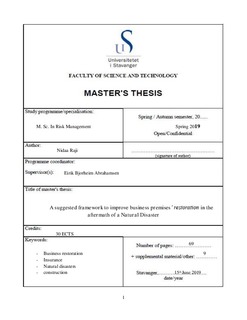| dc.description.abstract | Natural disasters are a low probability and high impact kind of risks. In those cases, businesses tend to ignore the probabilities of their happening and a lot of them end up closing their doors out of lack of good risk management.
In order to be prepared for a natural disaster, one should know the disaster, know the different kinds of outcomes, know what barriers they have. To be aware of a risk is to be conscious about its outcomes.
For natural catastrophes, the transfer of a high impact and a low probability risk is an effective response. A risk transfer in such situations is handled by an insurance that is expensive, especially to small businesses but, when a catastrophe strikes, the economical help offered is a rescue boat for the business.
In addition to the insurance, there are ways to improve the restoration of the building where the business is held. This thesis suggests framework to be considered by the business owners, for a faster resumption, as any time saved counts.
The suggestions are a use of a scenario preparation and analyze steps to follow for each possible situation precising who is responsible of the completion of each step. From this analysis and its outcome, it will be recommended to have a checklist for the different scenarios and steps to go by, including when to contact the insurance company and an approximation of what would be covered according to the contracted schemes. This step will highlight the importance of the risk transfer and will identify if there is a need for contracting extra insurance. Nevertheless, these two suggestions would be lacking an important input if no relationship with the restoration company has been established to perform them adequately; it is helpful to know beforehand what kind of business it run in the premises and the importance of different areas in the building. The insight of a restoration company is also needed to know the restoration steps required for the scenario analysis and checklists. | nb_NO |
